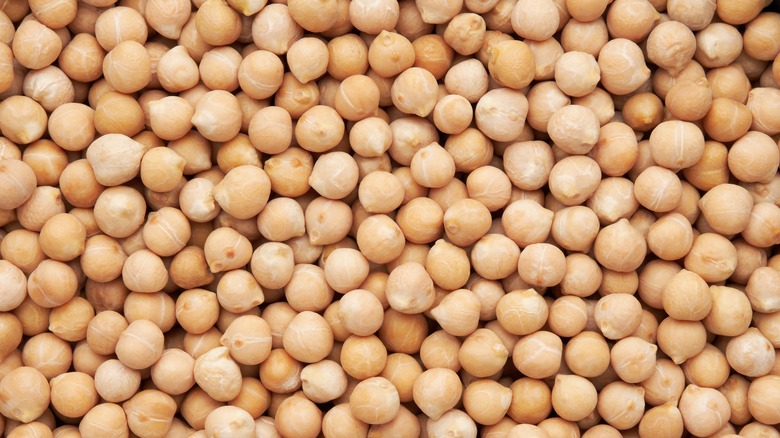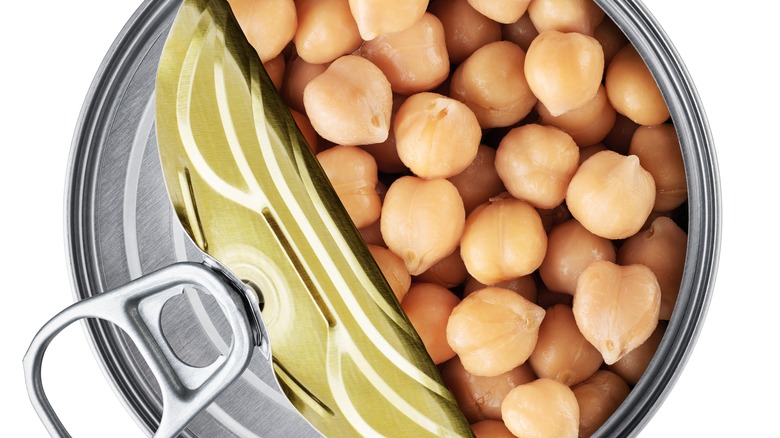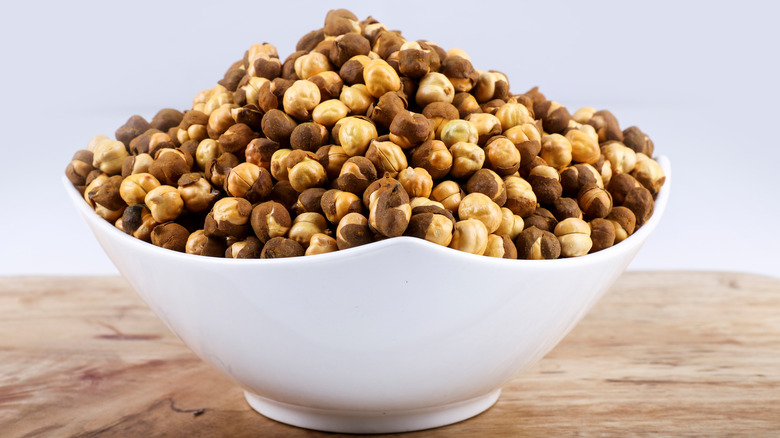The 2 Main Types Of Chickpeas And Their Differences
We know chickpeas have protein, nutrients like manganese and vitamin B9, and that they ability to aid in weight loss and blood sugar regulation (via Healthline). But we love chickpeas because we can blend them into hummus, fry them up crispy, and toss them in salads. But did you know that there's actually two different types of popular chickpeas? Like with bananas, we generally only find one kind of chickpea in American grocery stores. But venture beyond the U.S. and you'll learn there's another type that is enjoyed.
The chickpea originally worked its way into our diets about 7,500 years ago in the Mediterranean region and the Middle East, according to Tori Avey, making them one of the first legumes harvested by people. In the Bronze Age, notes the New World Encyclopedia, they were made into a broth or eaten as a snack in Italy and Greece, and were even thought to help with medical issues like kidney stones. It's clear that chickpeas have historically been popular in other parts of the world, but in the past decade, the U.S. has embraced them as the demand for plant-based proteins has increased (via Feast and Field).
If that's true, then why is only one type of chickpea readily available in America? Let's break down the differences between these two types of world-famous legumes.
Kabuli chickpeas dominate American grocery stores
The variety most Americans will be familiar with is kabuli chickpeas. Also called garbanzo beans, kabuli chickpeas are the larger and lighter-colored of the two, according to the Harvard School of Public Health, and they have a smooth texture with a nutty, buttery flavor. Each pod on the chickpea plant generally only contains one seed that has an extremely thin seed coat — as anyone who has rinsed a can of chickpeas knows because too much water pressure can cause the coat to rip (via USA Pulses).
The name kabuli means "from Kabul" in Hindi, as Indians originally believed these chickpeas came from Afghanistan (via New World Encyclopedia). Now harvested mainly in the Mediterranean and South America, kabuli chickpeas are commonly eaten whole or made into falafel, flour, pasta, and much more, shares the Cono Group. Garbanzo beans can even be used to make aquafaba, a vegan egg replacement that involves cooking canned chickpea liquid, making kabuli chickpeas a truly versatile ingredient.
Desi chickpeas are India's favorite
The difference between kabuli and the other variety, desi chickpeas, is pretty obvious at first glance. According to My Favourite Pastime, desi chickpeas are smaller, darker brown, and have a thick coat, which may be why they're sometimes called kala chanas or black chickpeas. Before desi chickpeas can be eaten, USA Pulses notes that the moisture level of the seeds needs to be modified in order for machines to remove their thick hulls.
Desi chickpeas are extremely popular in Indian food, and India leads the pack when it comes to chickpea production (via New World Encyclopedia). However, desi chickpeas are used in far fewer ways than their kabuli brethren. According to Clove Garden, they're mostly peeled and split to make chana dal (split chickpeas), which are prized in India because of their ability to cook quickly, and feed large amounts of people in soups or stews. However, desi chickpeas can also be ground into besan or gram flour, which is gluten-free and chock-full of protein and fiber (via Piping Pot Curry).
Are you convinced to try desi chickpeas yet? If you want to attempt to make chana dal yourself, or just want to branch out in the chickpea realm, the easiest way to find them might be online at retailers like Walmart. Or, if you want to skip a few steps, besan flour can usually be found in the international aisle of grocery stores or at international markets.


